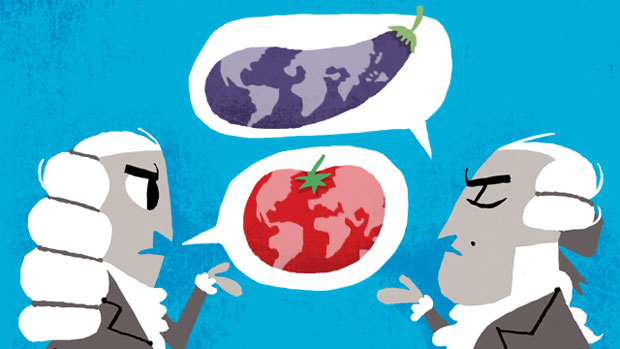
Two hundred and thirty years ago, Charles Marie de la Condamine returned to France with proof about the shape of the Earth, after spending 10 years in Latin America. For thousands of years, human beings had roamed the planet — indifferent to its form, until the 18th century, when the subject became embroiled in an intense rivalry between England and France. Isaac Newton had hypothesised at the end of the previous century that the Earth was like a tomato, round at the centre and flat at both ends. France’s great 17th-century scientist, Rene Descartes, had said nothing about the planet’s outline, but because it takes a horse to beat a horse, French controversialists turned to him anyway, deducing from Descartes’ writing that the shape was a thick tube, long and straight, more like a Japanese eggplant than a tomato.
Voltaire, who had come back from three years in London a thorough-going Anglophile, plumped for the tomato, but most French intellectuals bet on the eggplant. Jean le Rond d’Alembert, the famous editor of the Encyclopedie, declared it a “question of national honour not to let the Earth have a foreign shape, a figure imagined by an Englishman or a Dutchman”. Contentious discussions were so fraying the mandatory civility of the French Academy that one member proposed two expeditions to settle the matter. If a degree of longitude at the equator was greater than one at the North Pole, then Newton would be proved right. If they were the same, the French position would be vindicated.
Two of the brightest, wittiest men to grace Parisian salons volunteered for the expeditions: La Condamine and Pierre-Louis Moreau de Maupertuis. Best friends, neither seemed fitted for the rigours of Andean climbs or Arctic hikes, but they were young. Both were in their mid-30s and had once had army commissions. They were also mathematicians. Maupertuis studied the subject so that he could understand Newton’s Principia. La Condamine used his mathematical skills in a more roguish manner. His scrutiny of the French lottery indicated that those in charge of it inadvertently gave out more money than they took in. He got Voltaire to fund a scheme to game the system that netted them both a small fortune.
The prospect of the two expeditions thrilled the habitues of Paris salons. Geodesy, the study of the shape and area of the Earth, became a fashionable topic. Quickly, a team of astronomers and mapmakers was assembled. They bought the finest instruments available in London, secured permission from the secretive Spanish monarch to enter his territory, and chose a route to the Arctic through Lapland. The president of the French Academy dubbed them “the new Argonauts” when the two groups departed, in 1735 and 1736.
Maupertuis’ 16 months in Lapland was hardly a romp, but it paled in comparison to the six years the equator team spent ascending into cloud-shrouded Andean peaks and lugging their equipment through snow drifts. The Arctic expedition had eight astronomers, five servants, an interpreter and 21 soldiers to level the trees to make sight lines. They even managed to start a forest fire. Unlike the Laplanders, who stayed put in summer, the astronomers and their aides had to take advantage of the sunlight and sallied forth in heavy reindeer coats to shield themselves from mosquitoes famous for their ferocity. Once back home with his findings — a degree of longitude towards the top of the world was at least smaller than one near Paris — Maupertuis seconded Newton in his book La figure de la Terre.
News of Maupertuis’ triumphal return dampened the spirits of La Condamine’s equally large group, but they knew that Maupertuis had only one figure, not the two that would clinch the whole geodesic question. So they soldiered on, measuring the arc of the Earth’s curvature at the equator. They battled storms so fierce that their servants lashed shut the doors to their mountain huts. How the servants fared is not recorded. La Condamine also found time to study the caoutchouc tree, whose resin produced the amazing bouncing balls of the natives, and cinchona, the source of quinine. His group also came up with a standardised land measurement, the metre, and discovered the element platinum, from which the Indians made their jewellery.
After six years reconfirming all of their figures, the French were ready to go home, only to discover that the Spanish officials found their talents too valuable to let them leave. Undaunted, La Condamine rafted down the 3,000-mile (4,828km) Amazon River to reach French Guiana. He mapped the river and plumbed its depths, visited Jesuit missions along the way and learned from the Indians their techniques for hunting game with blowguns and poison darts.
The Earth in fact was shaped like a tomato, and La Condamine quickly brought out two works advertising this fact. The third — his diary covering the 10 years he spent in the New World — turned South America into an area of intrinsic interest to Europeans. If French scientists and intellectuals lamented that Newton’s tomato won over their Japanese eggplant, they could comfort themselves on producing intellectuals of rare curiosity, endurance and courage.
— Los Angeles Times
Joyce Appleby is an emeritus professor of history at the University of California, Los Angeles and the author, most recently, of Shores of Knowledge: New World Discoveries and the Scientific Imagination.









